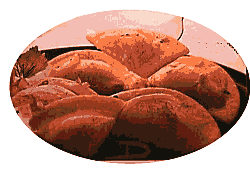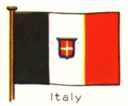|
|
|




4 cups all purpose flour
2 eggs
1 tsp salt
3/4 - 1 cup warm water
(Some cooks like to cut down on the water and add about a 1/2 cup of sour cream to the dough. I've also heard of chicken stock or bouillon being substituted for the warm water)
Combine the ingredients and knead until well blended. The dough should be somewhat dry, otherwise it sticks to everything. I like to start with a relatively moist dough, then coat my hands with flour and keep kneading until the dough is ready to roll. Only a little experience will tell you exactly when the dough is right, but the consistency should be about that of Play Doh.
Twist off workable portions of dough and roll out very thin on a floured board or table. Then, take a cup or glass with a thin lip (dip lip in flour) and press circles through the dough. Use a spoon to put filling (recipes to follow) in the center of each circle, then fold in half and press edges together until sealed. Drop sealed pierogi a few at a time into a pot of boiling, salted water. Stir to keep from sticking to the bottom and remove when they float to the top. Rinse in cold water, then drizzle melted butter or vegetable oil over dough to keep from sticking. Refrigerate or freeze until ready to cook.
Simple, eh?
I like to prepare mine by frying them in butter and onions. Some folks prefer to eat them just boiled. Others deep fry them until golden brown.
SOME TIPS: You decide on the size to make your pierogi. Select an appropriate cutting form. When I made pierogi for my church recently I used a small juice glass to cut the circles. That way I made a lot of bite-size pierogi, just a bit larger than ravioli, so that everyone could enjoy a variety of fillings. I also deep-fried them so that they could be put in a warming oven during Sunday service and were ready in time for the Fellowship Hour.
Don't even think about making a few pierogi! Make a few dozen at a time and use a variety of fillings. They freeze well, and once they're made they can be prepared quickly by boiling, microwaving, or frying, so they're great to keep on hand.


1 large can chicken broth or 1 1/4 qt. homemade
10 cut up pitted prunes
1/2 cup raisins
1/2 apple or pear, cut up (optional, but
Mix ingredients and simmer for 1/2 hour. Take off flame. To thicken, blend 2 Tbs. cornstarch with a little water, then add a heaping TB of sour cream and gradually to soup.
Best served with thick kluski noodles.
For diabetic diets the sugar may be omitted with each diner adding sugar to their individual servings.
My grandmother lived on the west side of Detroit in a heavily urban area near McGraw and Livernois from 1916 until her death in 1957. Nevertheless, she kept rabbits, chickens and pigeons in her backyard. When she got a duck at the farmer's market on Warren and Livernois, she'd save the feathers for quilts, the bones for fertilizer, and use the blood for soup.

Saute garlic and onions in olive oil until lightly browned. Add remaining ingredients and simmer for 90 minutes or more. Stir occasionally to avoid burning sauce at the bottom of the pan.
Once you're comfortable with the recipe, add or subtract seasonings to taste.
Hint: Double, triple, or otherwise increase amounts. Save old commercial spaghetti sauce jars. Put extra sauce in jars and freeze. Be sure to leave headroom in jars and don't seal until contents are chilled to avoid exploding jars.

Brown the ground beef, then drain the grease. Add all the remaining ingredients and simmer until flavors are blended (at least 45 min. -- better yet, cook in slow cooker or crockpot for a few hours)
To serve, top with sliced olives, chopped shallots, grated cheese, sour cream, and/or whatever else you think might complement the dish. Set out a bowl of corn chips, tortilla chips, Sun chips, Doritoes or crackers and enjoy the dipping.